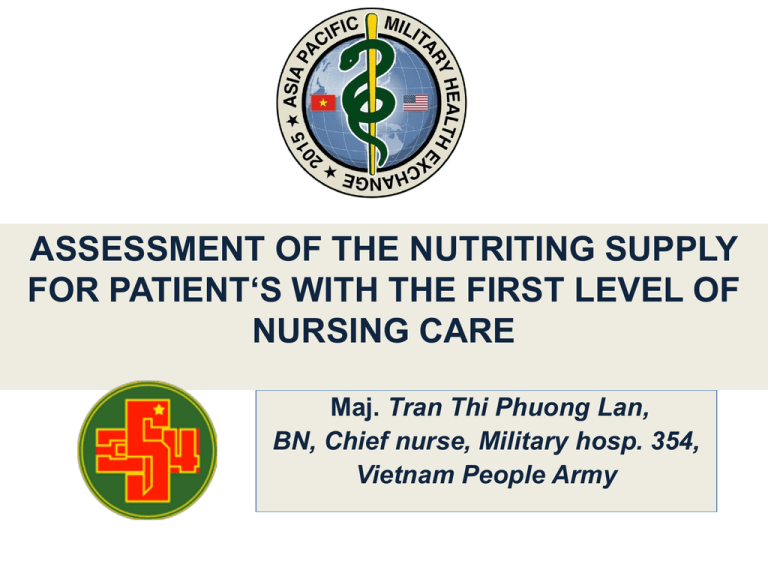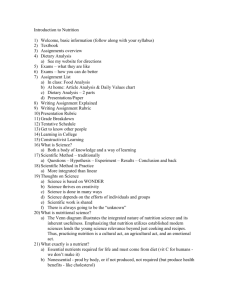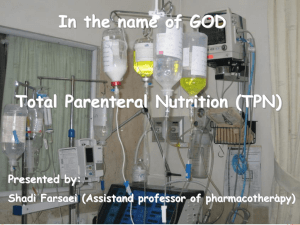Lan Wed 1315
advertisement

ASSESSMENT OF THE NUTRITING SUPPLY FOR PATIENT‘S WITH THE FIRST LEVEL OF NURSING CARE Maj. Tran Thi Phuong Lan, BN, Chief nurse, Military hosp. 354, Vietnam People Army 1. BACKGROUND Nutrition has an important role with human health. 1. BACKGROUND Nursing is caring for patients 1. BACKGROUND Patients usually care about doctors prescribe medication much or less. A study in whole country of Bach Mai hospital in 2011 shows: The ratio of inpatient malnutrition reached nearly 50% depended on age and department. Especially, the ratio of surgical patient is 78%. 1. BACKGROUND In fact, at 354 MH, in recent year, clinical nutrition problem was cared. Hospital contributed 17 regimes. OBJECTIVE 1. Assess the reality of clinical nutrition supply. 2. Propose the appropriated way of clinical nutrition. SUBJECT 252 patients hospitalized are fed by intravenous and/or gastrointestinal way through sonde in the first 3 days at: 1. Gastrointestinal - hematology dept. (GHD). 2. Intensive care Unit (ICU). 3. General Surgical dept (GSD). Of 354 MH from Sep 2012 to Sep 2013. METHOD Cross-section description combine with prospective and retrospective. Chose patients randomly. Patients fed by intravenous and/or gastrointestinal way (level 1 nursing care) at least 3 days. Patients are closely controlled diet . Build the following up diet table for patient each day Calculate kcal BMR (Basal Metabolic Rate). BMR = BEE + AF + TF + IF + WG. BMR = BEE + AF + TF + IF + WG. 1. 2. 3. 4. 5. Including: BEE (Basal Energy Expenditure) AF (Activities Factor) TF (Thermal Factor) IF (Injury Factor) WG (Weight gain) Calculate exchanging Nutrition and Kcal: 1 Kcal is considered the essential energy to warm 1 liter water up 10C, at general condition. + 100g rice contains 75g starch (1g glucose is 4 kcal). + 100g red meat contains 20g protein (1g is 4 kcal) and 31g lipid (1g is 9 kcal). THE ENERGY OF FLUID Kind of fluid 500ml Dextrose 5% (25 g Glucose) 500ml Dextrose 10% (50 g Glucose) 500ml Dextrose 20% (100g Glucose) 500ml Dextrose 30% (150g Glucose) 1000ml Lipovenous 10% 250 ml Lipovenous 10% 1000ml Alvesin/Chiamin S 250 ml Alvesin/Chiamin S • • • • Kcal 100 200 400 600 1.080 270 370 92,5 THE RESEARCHING TARGETS Characterize about age and gender. Disease structure. Feeding ways: intravenous and/or gastro-intestine. The situation of nutrition ensuring with demand: Follow each day of each department, the feeding way, the weight, assess the requirement report about diet of nurses. 3. RESULT AND DISSCUSSION General characteristics Age 120 100 80 60 40 20 0 GHD ICU GSD Gender GSD 18.0% 82.0% ICU 15.7% GHD 23.3% 76.7% 84.3% Male female Method of treatment 6.7% 17.1% 76.2% Internal Surgical Combination Disease Structure 80.9% 35.3% 24.6% 11.% 2.% 2.0% 1.2% 6.8% 15.9% Feeding way 38.9% 51.6% 9.5% Intravenous Gastrointestine Combination The reality of nutrition ensuring for patien The feeding ways 4. CONCLUSION General characteristics of object •The general characteristics of patient : Age 61-100: 57.5% Male: 82.9% Inpatient: 76.2% Brain stroke: 35.3% Other diseases: 80.9%. • Out of 252 patients that are fed by different ways: Intravenous: 38.9%, Gastrointestine: 9.5% Other: 51.6% The reality of nutrition ensuring for patient • Energy balance: First day: 27% Second day: 38.1% Third day: 40.1% •Energy support related to nutrition way : Combination: 70% Intravenous: 15.3% Gastrointestine: 20.8% * Energy support related to weight: 33.3% to 55.4%. •The ratio of patient acording to reports from nurse: Intravenous: 100%, Gastrointestine: 25% Combination: 43.8%. 5. RECOMMENDATION Increase the education for patients about the role of nutrition in treatment. Train the doctors and nurses about clinical nutrition and diet suitable with the disease situation. Thank you! My e-mail address: phuonglan354@gmail.com



